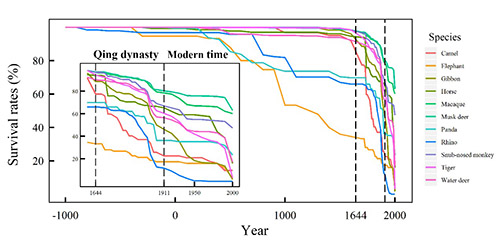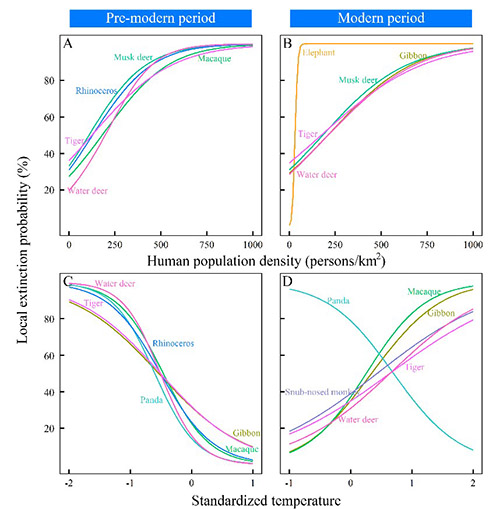Global biodiversity has been declining rapidly in modern times. Accelerated anthropogenic impact and climatic change are widely blamed to be responsible for unprecedented species extinction. But, quantitative relationships between local extinction of animals and anthropogenic or climatic factors have been rarely evaluated. This prevents us from disentangling the relative roles of human impacts and climate change in causing population decline or local extinction of species, and to take effective conservation actions. Because human disturbance and climate change are often highly correlated, it is still challenging to disentangle their distinctive effects on population change. Solving this problem needs long-term spatial-temporal data of animal populations.
China has a long history of recording significant political and natural events for over 3000 years, sightings of medium- or large-sized mammals, reports of human-animal conflicts or gifts to the Emperor and captures of these animals were frequently recorded in Chinese historical literature. This kind of data gives us a good opportunity of reconstructing the long-term spatial-temporal occurrence of animals, and analyzingtheir associations with climate change and human activities.
In a study published in Proceedings of the National Academy of Sciences, the researchers from the Institute of Zoology and National Science Library of Chinese Academy of Sciences, Northeast Forestry University, East China Normal University, University of Alberta, and University of Oslo studied historical records of 11 medium- to large-sized mammal species (or groups of species) in China from 905 B.C. to 2006 A.D., quantified the distinctive associations of anthropogenic stressors (represented by cropland coverage and human population density) and climatic stressors (represented by air temperature) with the local extinction of these mammals.
Their results showed that the population of large-sized mammals declined larger and earlier than small-sized mammals over the past two millennia, and all mammals showed precipitous population declines since the Qing Dynasty. Large-sized mammals, such as elephants, rhinos and panda, showed earlier and larger population declines than small-sized ones.
They found that the increased local extinction of mammals was associated with intensified human disturbance (particularly for large-sized mammals) and with extreme temperature change (both cooling and warming). In the cold phase (the pre-modern period of China), climate cooling was positively associated with increased local extinction, while in the warm phase (the modern period), global warming was associated with increased local extinction. The interactive effects of climate change and human disturbance was also found for some species, suggesting that habitat fragmentation caused by human activities might accelerate local extinction of mammals by preventing their movement along latitude or altitude under the pressure of climate cooling or warming.
The study provided a modeling solution of identifying the distinctive effects of anthropogenic and climatic on population decline and local extinction of animals, and provided novel insights into the driving processes of species extinction under global change.
This study would have some important implications for biodiversity monitoring and conservation under the accelerated global change in the Anthropocene. First, it is essential to reduce the impacts of human disturbances on animals and their habitats. Second, to help animals to cope with the climate change, it is necessary to build large reserves or wildlife corridors connecting isolated habitats to facilitate animal movement along altitudes or latitudes under accelerated climate warming.

Fig. 1. Survival rates (percent, i.e., the proportion of survived grids compared to all distributed grids in history) of 11 large mammal species or groups of species caused by local extinctions in China during 905 B.C. to 2006 A.D.

Fig.2: Relationship of the local extinction probability with the average human population density (A, pre-modern period; B, modern period) and the average standardized summer air temperature (C, pre-modern period; D, modern period). Different colored lines represent the responses of local extinction probability of the 11 mammal species or groups of species to different stressors.


